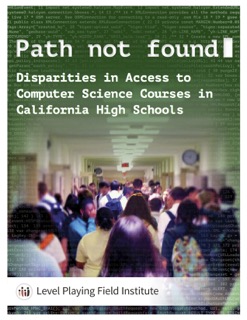“Path Not Found” – Report Says Low-income Students Lack Computer Access
May 24, 2015
Posted in Economic Development, Education/Schools/Youth, Equal Rights/Equity
By Nikolas Zelinski
The Level Playing Field Institute (LPFI) has released a report titled a “Path Not Found” that chronicles the lack of computer classes available to lower-income students and students of color in California high schools.
The report finds “the higher a school’s percentage of underrepresented students of color, the lower the likelihood of a school offering any computer science courses whatsoever.”
Nearly 75 percent of high schools with the highest percentages of underrepresented students of color offer no computer science courses, and 75 percent of high schools with the highest numbers of low-income students offer no computer science courses.
This is during a time when the tech industry is booming, and the country’s demographics are shifting. “Last fall, for the first time in history, students of color made up the majority of first graders nationwide,” according to the report.

This disparity is currently demonstrated by Google’s diversity data released last year. Combined, African Americans and Latinos only comprise five percent of the technical workforce. Other major tech companies show similar statistics.

Nationwide economic projections indicate that there will be more than 1.3 million job openings in computing and mathematical occupations by 2022.
During a press conference for the report, Mitch Kapor, founder of Lotus Corporation said, “All of my experience in the tech industry leads me to believe that no great startup can come into existence without skilled software developers. Because they’re the people that transform the visions and design into working code. Software developers are completely essential to the innovation economy.”
Kapor continued, “Even here in Silicon Valley, our schools are woefully behind in preparing the next generation to acquire these skills. We’ve seen time and time again, that students who are not born into privilege are at a disadvantage compared to their more privileged peers.”
According to Dr. Julie Flapan, executive director for the Alliance for California Computing Education for Students and Schools, “Upper-income schools have what we call preparatory privilege. Students who have exposure to computers at home, after-school coding classes, or summer robotics camps, are better prepared for the advanced placement (AP) courses that are already offered at their schools.”
“This is why it’s important to expand introductory level courses across the state, to ensure that all students have equal exposure to computer science,” Flapan concluded.
Some success in achieving demographic equality includes a program recently trialed in the Los Angeles Unified School District (LAUSD), in partnership with the University of California Los Angeles, and the National Science Foundation.
The equity focused curriculum called “Exploring Computer Science” shows participation directly mirrors the overall demographics of LAUSD. The course utilizes interest-based learning at its core, and uses that concept to teach web design, and coding.
To ensure computer access for underrepresented students of color, and underprivileged students, the “Path Not Found” report lists some key strategies.
One of the solutions is to make computer science count as either a mathematics course, or science high school graduation requirement.
Other methods include expanding access to in-school and out-of-school programs designed to develop computing interest among underrepresented groups; while emphasizing hands-on projects, field trips, extracurricular activities, and mentorship programs.
Also, ensure that funding prioritizes programs serving low-income students of color and other underrepresented groups.
Many members of the press conference panel explained that role-models who look like the students they are teaching is one of the biggest factors to success.